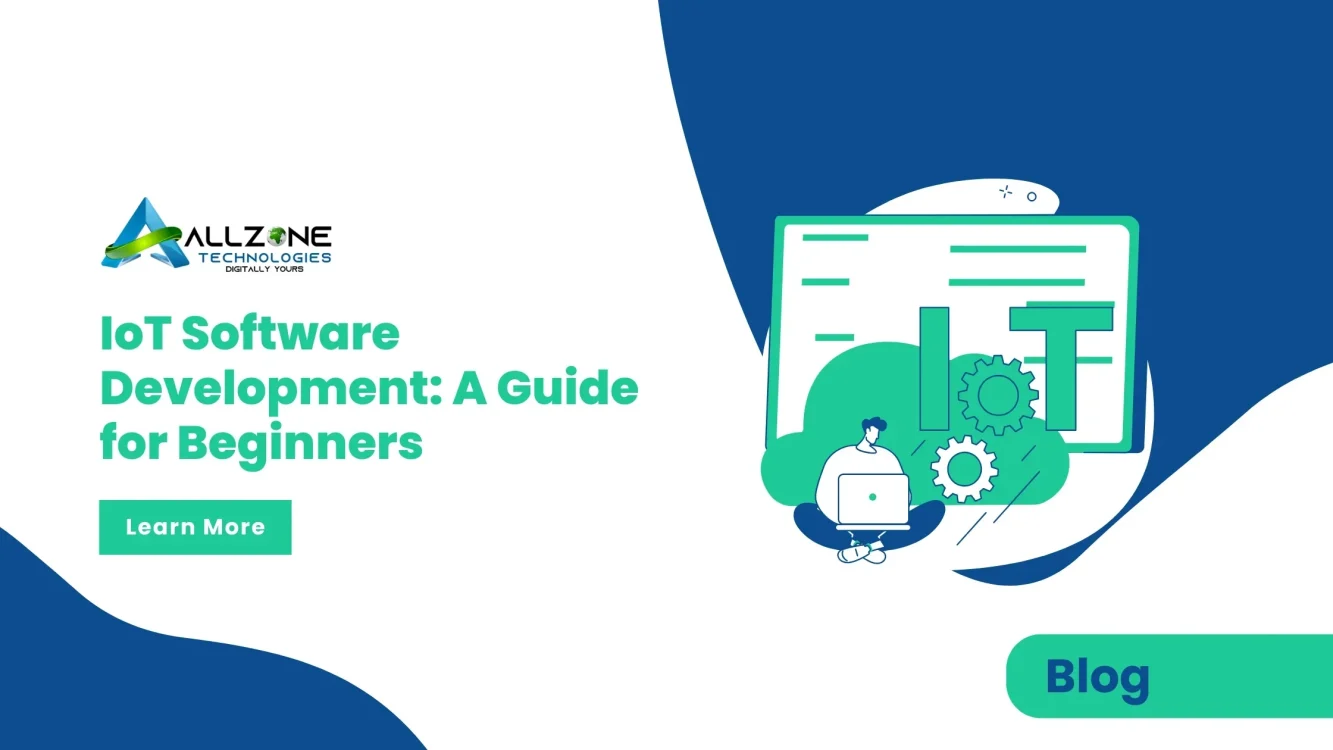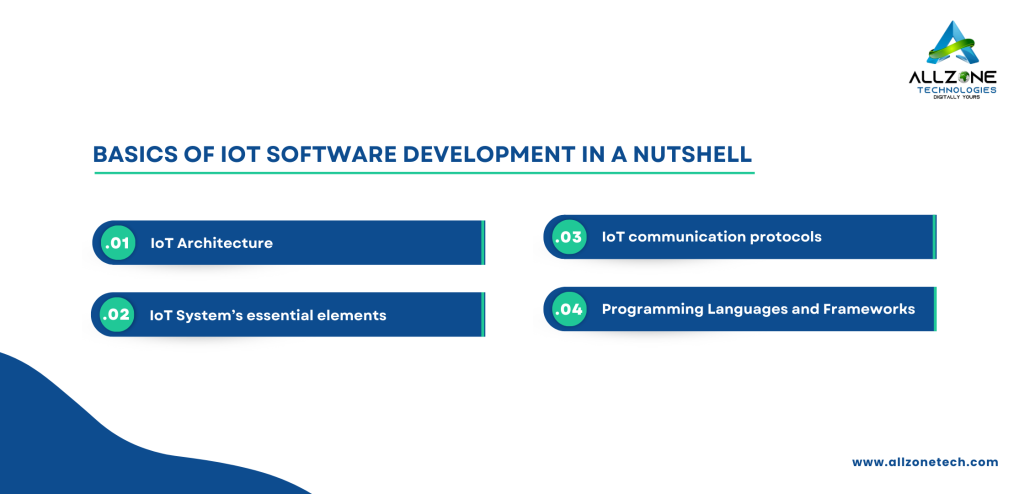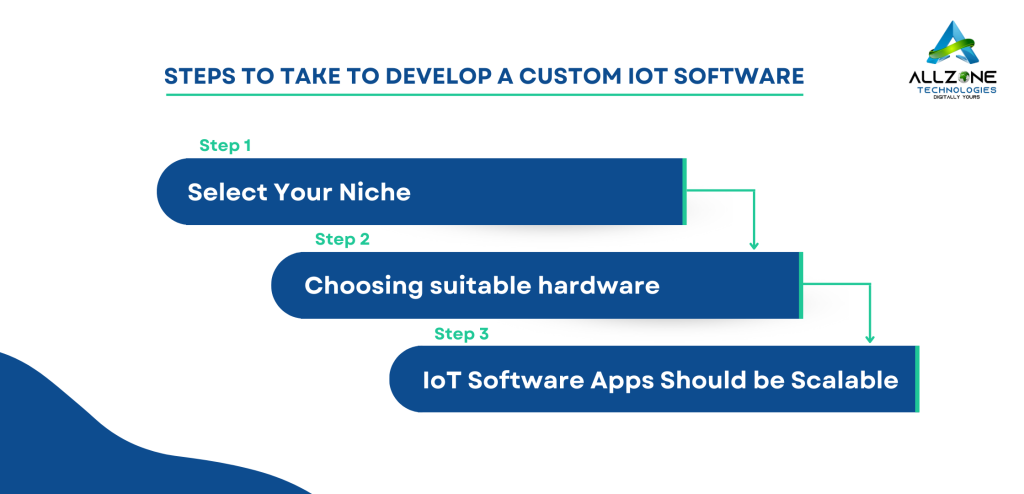
-
Muhammad Adnan
- November 3, 2023
IoT Software Development: A Guide for Beginners
IoT software development is at the sky heights. Welcome to our comprehensive guide to developing the Internet of Things (IoT) software. This guide will explain the effective strategies to develop successful software for IoT applications. No matter what, if you are a young software developer or a company that wants to explore IoT, the AllZone Technologies IoT software development guide will explain everything. You will learn about essential knowledge and can develop successful IoT software for sure.
Moreover, learn about the security, architecture, considerations, and top-notch ways to build ultimate IT solutions. Do you know IoT depends on the software for connectivity to perform optimally from cloud platforms and to the device firmware? This guide will help you learn about IoT software development for home automation, healthcare, and beyond.
IoT Adoption in Software Development: Key Statistics
- Gartner survey: 80% of businesses to adopt IoT by 2023.
- McKinsey & Company: IoT boosts productivity by 30%.
- IoT revolutionizes software development:
- Streamlines processes
- Improves efficiency
- Delivers innovative solutions
- competitive edge in the digital landscape
What is IoT Software Development?
A kind of software development that can connect and operate the Internet of Things (IoT) devices. So, IoT software development is the integration of developed software with devices, like monitors, controllers, wearables, appliances, and embedded sensors using the internet. IoT app development connects with the IoT devices to connect them. They also connect with the cloud-based servers that deal with the data received from the devices. So, applications can connect with the IoTs for many reasons, which include manufacturing, healthcare, home automation, logistics, and so on.
Basics of IoT Software Development in A Nutshell

Do you know the foundation of an interconnected world is dependent on smart devices? However, Internet of Things software development is the only reason behind it. Let’s explore the fundamental concepts and elements of IoT application development together:
IoT Architecture
One crucial thing that needs to be remembered is that IoT architecture is everything. It consists of interconnected elements that include sensors, actuators, cloud platforms, and gateways.
IoT System’s essential elements
Everything works in an IoT system in order, like sensors detect information related to the environment, and gateways help in communication. Moreover, devices gather and transmit data, and actuators work without input. However, cloud platforms deal with data processing and storage as well.
IoT communication protocols
HTTP CoAP and MQTT are the best examples of communication protocols performed in IoT for data sharing and messaging.
Programming Languages and Frameworks in IoT
There are several programming languages and frameworks in programming languages, such as Java, Python, C++, and Node.js. Moreover, frameworks, including Arduino and Raspberry Pi, are responsible for forming the IoT apps foundation.
Once you get to know about the IoT software development basics, it will become easy for you to know how IoT systems work and perform the groundwork for successful software development.
Further, consider the IoT app development keys consist of security and stability of the development lifecycle.
Why is IoT Software Development so crucial?
IoT or the Internet of Things introduced smart devices. As we all know smart devices do not require human input to perform any sort of activity. IoT automates the process with the help of sensors and through intelligent software.
Suppose a scenario in which you have a smart home system. You know it will consist of what elements? It could include smart lights, security cameras, and thermostats. The Internet of Things has the power to automate all these devices via a smartphone device.
Moreover, a single installed application on a cellphone device empowers you to deal with your room temperature. You can turn your lights on, and keep an eye on your house surroundings via security cameras in place. The application also keeps on indicating that something is wrong with a particular area via trigger warnings and messages. Do you know they trigger warning signs? The answer is via sensors. So, IoT has become a crucial source of comfort in humans’ lives.
IoT: Software Development Lifecycle

The IoT application development lifecycle involves building and deploying Internet of Things solutions. It follows a structured strategy to ensure speedy development, testing, deployment, and, last but not least, maintenance of an IoT application.
Analysis & Requirements
You need to know about the goals and objectives of a project before you get into it. Further, learn about the steps of data collection.
IoT System Design
It is essential to select the devices and connectivity measurements in place. Moreover, it ensures the APIs and data models and provides UX/UI.
Testing & Deployment
It is crucial to code all components of the code, device integration, and test the software to make it reliable and well-performed.
Maintenance
Ultimately, deploy the IoT application using CI/CD and ensure the OTA updates. Further, deploy monitoring and debugging.
How to Develop an IoT Software?
If you want to get started in IoT software development, you have come to the right place. The possibility of how IoT technology uses hardware and software has transformed the way a device works. It can produce interconnected devices and application solutions that do not require operating systems.
However, developing IoT software is a complex task that necessitates a thorough understanding of the most recent inventions and developments in computing software. It also required excellent knowledge about data transmission and reception among diverse devices. This is why many businesses seek to hire IoT application development companies. It can be cost-effective and eliminates the need to acquire all the necessary hardware and software tools.
Steps To Take to Develop A Custom IoT software:

Select Your Niche
The first and foremost important step in the cycle of custom IoT software development is to specify your niche. The Internet of Things constantly transforms almost every industry, from agriculture to IT and healthcare. Conducting thorough research before beginning the process of developing IoT applications can save you time and money. A few important things to consider before starting the development process are listed below.
- Formatting a plan for Software development
- Planning the workflow of the whole project
- An estimate of the resources needed
- Choosing the correct IoT platform
The next step is to determine which company is best suited for IoT development based on your niche and project requirements. Every company has its features and costs, so selecting the right one for your project can significantly impact it. Choosing the right platform can boost your productivity and efficiency while also providing valuable insights into the specific niche you want to work in. The following are some of the most popular IoT development platforms:
- Oracle IoT
- IBM Watson
- Android Things
- Xively
- Azure IoT Suite
Choosing suitable hardware
One of the most crucial aspects is choosing the proper hardware, which is responsible for transmitting data between two networks. All of the hardware components and power sources involved in the operation and functionality of software are categorized as hardware.
IoT Software Apps Should be Scalable
Internet of Things software must be scalable following the situations. Once you have made up your mind to develop an IoT app, ensure the scalability. Especially when buying hardware and software.
The Stage Where AllZone Technologies Offers Services
IoT technology has evolved, and it is growing day by day. The best examples are robots and smart devices that do not depend on human effort. On the other side, it is easier to implement an Internet of Things app with experience. Newbies often need help with the Internet of Things. However, you can enhance the skills. Do you need help figuring out where to begin? Contact AllZone Technologies for a comprehensive, detailed process overview. Our experts will put you in the driving seat, and you will put all your IoT software development challenges to rest.
Frequently Asked Questions:
What is IoT, and why is it important for beginners to learn about it?
IoT, also known as the Internet of Things, is a network of various hardware devices that are interconnected and can exchange data over the Internet. IoT is revolutionizing many industries and developing a wide range of applications. Beginners should learn more about it because it provides exciting career opportunities, potential ideas, and the ability to solve real-world problems.
What are the critical components of IoT software development?
There are numerous essential elements in IoT software development. Among them are data processing, cloud computing, communication protocols, sensors and actuators, and user interfaces. It is critical to learn and comprehend these components in order to create an effective IoT solution.
What programming languages are commonly used in IoT development for beginners?
IoT developers work with a wide variety of programming languages. Languages like Python, C, and JavaScript are frequently suggested as good places for beginners to start. These flexible languages have numerous libraries and structures that simplify IoT application development.
How can beginners get started with IoT software development?
Beginners should take the following steps to get started with IoT software development:
- Learn the fundamentals of computer programming.
- Know the basics of the Internet of Things (IoT) architecture.
- Test small-scale IoT projects with the help of development kits and
- Look for resources, tutorials, and courses on the Internet.
- Link with IoT groups and other platforms to gain knowledge and connect with experts.
What are some common challenges in IoT software development for beginners, and how can they be overcome?
For those new to IoT development, dealing with data streams, security concerns, and hardware compatibility issues are common roadblocks. These difficulties can be carefully managed by conducting quick research, adhering to best practices, and getting advice from specialists and developers.
What are some real-world examples of IoT applications that beginners can learn from?
IoT applications in the real world, like smart home automation, wearable health monitoring, smart agriculture, industrial automation, and environmental monitoring, can teach beginners a lot. For individuals wishing to improve their IoT skills, these examples offer insightful perspectives on the various uses of IoT technology.

